wagon
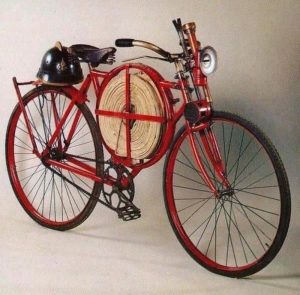 At the turn of the century, some firefighters arrived at the fire in a slightly different way than the normal truck or wagon. I don’t suppose that this was a common practice, because in most cases, it would be impractical, but for the firefighters in the workshops of Birmingham Small Arms in Great Britain, it was the normal mode of transportation. Birmingham Small Arms built a special bicycle for their firefighters. The bicycle would be an interesting way to ride to and from work, as well, but this one was to be used for a very special purpose. I would think that there might have been several businesses like Birmingham Small Arms, that utilized this type of firefighting “truck.”
At the turn of the century, some firefighters arrived at the fire in a slightly different way than the normal truck or wagon. I don’t suppose that this was a common practice, because in most cases, it would be impractical, but for the firefighters in the workshops of Birmingham Small Arms in Great Britain, it was the normal mode of transportation. Birmingham Small Arms built a special bicycle for their firefighters. The bicycle would be an interesting way to ride to and from work, as well, but this one was to be used for a very special purpose. I would think that there might have been several businesses like Birmingham Small Arms, that utilized this type of firefighting “truck.”
The bicycle was equipped with a fire hose that could be hooked up to a hydrant, and a spindle to hold it. It also held a crowbar to get into buildings, and a flashlight so the firefighter could see to get around in the dark. The bicycle wouldn’t be practical in a big city, but for a small town, or a company yard, it was perfect. I can see where it 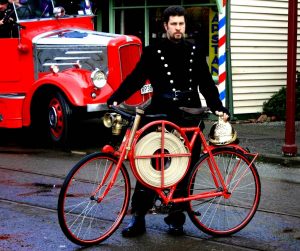 could be problematic if they tried to use the bicycle in the wintertime, but the other season would be ok for the most part.
could be problematic if they tried to use the bicycle in the wintertime, but the other season would be ok for the most part.
Of course, I can see some ways in which the fire bike would not really be the best option. Fire hose has a lot of pressure, and so, would it knock the bicycle over. Also, I’m not sure how wide the firehose spindle is, but it seems to me that it could make peddling difficult. I’m not sure how heavy of how well balanced the bicycle is, but it seems like it might be top heavy. Given the possible problems with the fire bike, I think it might be best to stick with a fire truck. The modern day firetrucks are able to carry lots of other equipment that is necessary to fighting fires. They can also go most places, in all kinds of weather…just a better idea, in the long run.
 Most people know what the paddy wagon is, and nobody wants to end up in one. An old term for arresting vehicle, the term gets it’s roots from the Irish. Apparently, many of the police officers in early America were of Irish descent. According to Dictionary.com, “Irishman,” 1780, slang, from the pet form of the common Irish proper name Patrick (Irish Padraig). It was in use in black slang by 1946 for any “white person.” Paddy wagon is 1930, perhaps so called because many police officers were Irish. Paddywhack (1881) originally meant “an Irishman.” I suppose that many would look at this slang name for police officer as disrespectful, and they might be right, but no more disrespectful that pig or even cop. Nevertheless, the Paddy Wagon was just a
Most people know what the paddy wagon is, and nobody wants to end up in one. An old term for arresting vehicle, the term gets it’s roots from the Irish. Apparently, many of the police officers in early America were of Irish descent. According to Dictionary.com, “Irishman,” 1780, slang, from the pet form of the common Irish proper name Patrick (Irish Padraig). It was in use in black slang by 1946 for any “white person.” Paddy wagon is 1930, perhaps so called because many police officers were Irish. Paddywhack (1881) originally meant “an Irishman.” I suppose that many would look at this slang name for police officer as disrespectful, and they might be right, but no more disrespectful that pig or even cop. Nevertheless, the Paddy Wagon was just a 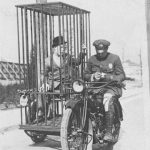 vehicle used to transport prisoners to jail. These days, unless it is a big group being arrested at one time, paddy wagons aren’t used much, but they used to be much more common. I’m sure there were many outlaws who knew the inside of a paddy wagon well…at least the ones who were’t very good at their skill. Those who were good at it usually avoided the paddy wagons.
vehicle used to transport prisoners to jail. These days, unless it is a big group being arrested at one time, paddy wagons aren’t used much, but they used to be much more common. I’m sure there were many outlaws who knew the inside of a paddy wagon well…at least the ones who were’t very good at their skill. Those who were good at it usually avoided the paddy wagons.
Back in the Old West, paddy wagons really were wagons, but then so was every other mode of personal transportation, and many forms of business transportation. With the invention of the motorized vehicle, came a different type of Paddy Wagon too. And with the invention of the motorcycle, came an even more unusual type of Paddy Wagon. I 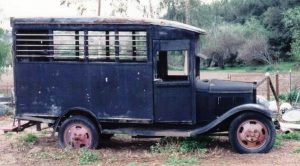 can’t really imagine being taken to jail in a cage attached to a motorcycle, but there were those who were taken that way. This seemed to be common in Los Angeles, which makes sense, because many other places would be too cold for that. Still, imagine being hauled to jail in a cage for all the locals to see. No privacy there. I suppose that would be a special type of punishment for sure, the crime and the embarrassment. Or maybe criminals don’t get embarrassed. I can’t really say. All I know is that if I ever had to be hauled to jail in a Paddy Wagon, I would prefer the type we have today, with no windows.
can’t really imagine being taken to jail in a cage attached to a motorcycle, but there were those who were taken that way. This seemed to be common in Los Angeles, which makes sense, because many other places would be too cold for that. Still, imagine being hauled to jail in a cage for all the locals to see. No privacy there. I suppose that would be a special type of punishment for sure, the crime and the embarrassment. Or maybe criminals don’t get embarrassed. I can’t really say. All I know is that if I ever had to be hauled to jail in a Paddy Wagon, I would prefer the type we have today, with no windows.
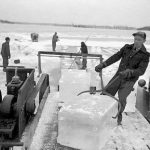 Before the 1830’s, food was preserved by salting, spicing, pickling or smoking. The people back then had no refrigerators, so butchers slaughtered meat only for the day’s trade, as preservation for longer periods was not practical unless you made jerky or something. Dairy products and fresh fruits and vegetables subject to spoilage were sold in local markets since storage and shipping farm produce over any significant distance or time was impossible. Milk was often hauled to city markets at night when temperatures were cooler. Ale and beer making required cool temperatures, so its manufacture was limited to the cooler months. The solution to these problems was found in the harvesting of natural ice.
Before the 1830’s, food was preserved by salting, spicing, pickling or smoking. The people back then had no refrigerators, so butchers slaughtered meat only for the day’s trade, as preservation for longer periods was not practical unless you made jerky or something. Dairy products and fresh fruits and vegetables subject to spoilage were sold in local markets since storage and shipping farm produce over any significant distance or time was impossible. Milk was often hauled to city markets at night when temperatures were cooler. Ale and beer making required cool temperatures, so its manufacture was limited to the cooler months. The solution to these problems was found in the harvesting of natural ice.
Before the invention of refrigerators in the early twentieth century, ice was harvested every winter from the lakes and stored in large ice houses, the proprietors then sold the ice to shippers of fresh fish, waterfowl, and produce for train deliveries to large cities. The ice harvesting process was labor intensive, requiring 20-100 men for one to four weeks. I suppose it was good temporarily, but was not permanent work.
Nineteenth-century ice harvesting began well before the actual cutting. As soon as the ice was strong and thick enough to support horses and equipment, work forces cleared away the insulating snow, sometimes many times, if necessary, to encourage the formation of stackable, thicker blocks. When the ice was thick enough, the field was marked in squares, using a horse-drawn marker, which scored slightly deeper into the ice, and finally the blocks were cut by hand with the use of large-toothed one-man saws. The blocks were then floated to the large adjacent commercial ice house for stacking, or to a railroad loading ramp for shipping. The system worked pretty well, and lasted throughout the century, the major change being the late introduction of rotary saws that replaced hand-cutting, making the job much easier.
The latter half of the 19th century saw many attempts to perfect manufactured ice methods. The Louisiana Ice Manufacturing Company appears to have been the first one to operate regularly, one of its claims being a price considerably lower than that of natural ice. Others followed. By 1925 factory-made ice had entered the realm of big business, and natural ice had become a thing of the past…just like that. In the 19th century commercial ice houses were constructed to provide ice for general use, to stock private ice houses when supplies from the local pool were scarce and later to produce “frozen” food. Some of these ice house’s were really a barn within a barn, with 3 feet of sawdust and hay between the inner and outer walls. City dwellers had ice delivered to them by horse and wagon. The iceman had to lift from 25 to 100 pound blocks, according to the order, which was placed by the consumer putting a numbered card in the window that corresponded with the number of pounds of ice they wanted. The ice was weighed on a spring scale on the truck, but an experienced delivery man could estimate the weight. The ice was carried to a kitchen using ice tongs, and chipped with chisels to fit the compartment of the ice box.
Delivery men were known for their brawn, as they hauled heavy blocks of ice all day long, and often up flights of stairs. Nevertheless, occasionally two women teams delivered the ice. They often had access to the kitchen when no one was home, and they simply placed the ice appropriately. Some city apartments used a suspended box (a small version of the ice box) outside the kitchen window, its contents available to the cook through the raised window; others kept an ice chest outdoors on the porch, or a handsome oak refrigerator in the kitchen. Ice wagons were great for children playing in summer’s heat. They loved when the iceman dropped his ice tongs and used his ice pick to chop a small piece of ice for them to suck on, similar to today’s ice cream trucks.
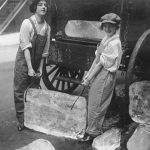
Residential ice boxes, many home-made, were of oak, pine, or ash wood lined with zinc, slate, porcelain, galvanized metal or wood. The insulator between the walls was charcoal, cork, flax straw or mineral wool. Still, the ice lasted only one day. Wooden boxes lined with tin or zinc and insulated with various materials including cork, sawdust, and seaweed were used to hold blocks of ice and “refrigerate” food. A drip pan collected the melt water…and had to be emptied daily. Electric refrigerators and freezers seriously hurt the ice industry. Although the first models were marketed before 1920. It would be a while before everyone had them, so ice delivery continued to be used, but declined yearly.
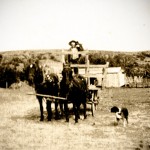 These days, a trip to the store is a minor part of the day, even if it is a weekly or monthly trip to buy groceries, but it wasn’t always so. Many, and in fact probably the majority of people live right in town now, so it’s easy to run to the store for forgotten milk or bread, but when people live in the country it is a little bit more of a big, planned out trip. In the old west, it was even more than that…it was an all day event…and a lot of people didn’t go to town very often. They bought what they needed in quantity, and didn’t go back in for a while.
These days, a trip to the store is a minor part of the day, even if it is a weekly or monthly trip to buy groceries, but it wasn’t always so. Many, and in fact probably the majority of people live right in town now, so it’s easy to run to the store for forgotten milk or bread, but when people live in the country it is a little bit more of a big, planned out trip. In the old west, it was even more than that…it was an all day event…and a lot of people didn’t go to town very often. They bought what they needed in quantity, and didn’t go back in for a while.
Now with the invention of the automobile, people travel a lot of places, not just into town. These days people drive all over the country, and into Canada and even Mexico sometimes. We have become a nation, and indeed world, of people on the move. In the old west, people had to plan trips around the country over the course of several months, because there was a lot of preparation needed to make such a trip. There weren’t hotels and restaurants all over the place to stay and eat at, so food had to be brought along, and cooked over a campfire when they stopped. It’s no wonder they didn’t go places very often. It all just took too long to make it a casual event.
These days, I can’t imagine people being patient enough take the time to get where they need to go in a wagon, pulled by horses…at least not most people. And I’m sure that even in the old west, people often wished there was a faster way. In fact, that is probably how the automobile 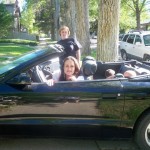 got invented in the first place. Inventions come for someone seeing a need, and in our world, there is a definite need for automobiles.
got invented in the first place. Inventions come for someone seeing a need, and in our world, there is a definite need for automobiles.
Nowadays, we have every kind of vehicle imaginable to get us where we need to go. There are sports cars for the fun ride, around town or to the store, pickups for those big jobs, vans for hauling lots of people, and SUV’s the ability to take a lot of things with you and a lot of people too. They come in every color and size to suit each drivers personal taste. I know there are still people who use a horse and buggy, but this girl is a child of the modern age, and I’ll stick to my sporty car…over a wagon any day.
 These days there are machines that can cut, bail, and stack hay with ease, but in times past, it was not so easy. There were machines that cut the hay, but then it had to be thrown up on a wagon with a pitchfork and hauled to where the haystack was going to be placed, unloaded and thrown up onto the haystack by hand using the pitchfork again. Then someone had to be up on the top leveling it out so that the ha could be stacked higher. It was no easy job, and the more people you had helping the better off you were. It was definitely not a job for one person, and definitely not for wimps. The farmer and his crew had arms of steel, because hay is not light, no matter how it looks. I have helped move hay bails, and found out for myself that it is not a job for lightweights.
These days there are machines that can cut, bail, and stack hay with ease, but in times past, it was not so easy. There were machines that cut the hay, but then it had to be thrown up on a wagon with a pitchfork and hauled to where the haystack was going to be placed, unloaded and thrown up onto the haystack by hand using the pitchfork again. Then someone had to be up on the top leveling it out so that the ha could be stacked higher. It was no easy job, and the more people you had helping the better off you were. It was definitely not a job for one person, and definitely not for wimps. The farmer and his crew had arms of steel, because hay is not light, no matter how it looks. I have helped move hay bails, and found out for myself that it is not a job for lightweights.
My dad’s family spent a lot of time making hay when they owned the farm in Minnesota, and  my Uncle Bill helped his wife’s family too over the years that they owned a farm. Load after load, they worked the weekend away. Moving the hay from the hayfield to the stack behind the old barn, where it would stay stacked until it was needed. It was hard work, but Uncle Bill was on his days off, and so they wanted to get as much done in the time they had before he had to go back to work in the shipyards. I haven’t had the impression that it was a job that any of them enjoyed very much, but rather it was a job that had to be done, so they did it. I think I can agree with Uncle Bill when he said that he was glad when hay making time was finally over. Now that we don’t raise cows, I can honestly say that moving hay around in any form, is something I don’t miss. I think it must have taken a very determined person to work a farm the way it had to be done back in the days when there weren’t all the machines there are these days. The work is hard enough these days, even with all the machines, so
my Uncle Bill helped his wife’s family too over the years that they owned a farm. Load after load, they worked the weekend away. Moving the hay from the hayfield to the stack behind the old barn, where it would stay stacked until it was needed. It was hard work, but Uncle Bill was on his days off, and so they wanted to get as much done in the time they had before he had to go back to work in the shipyards. I haven’t had the impression that it was a job that any of them enjoyed very much, but rather it was a job that had to be done, so they did it. I think I can agree with Uncle Bill when he said that he was glad when hay making time was finally over. Now that we don’t raise cows, I can honestly say that moving hay around in any form, is something I don’t miss. I think it must have taken a very determined person to work a farm the way it had to be done back in the days when there weren’t all the machines there are these days. The work is hard enough these days, even with all the machines, so 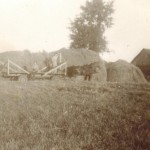 imagine what it would be like without them. No wonder those people were so strong.
imagine what it would be like without them. No wonder those people were so strong.
And after the hay was stacked, you had to use a pitch fork again to move it to where you needed it for the animals. So, now the whole process is reversed, as they haul the hay off of the stack, thereby bringing about the need to make more hay the next summer. Of course it is all necessary, and that is why farmers and ranchers do it. The hay is needed for the animals. This whole process causes me to really respect the farmer and rancher…especially the ones from days gone by because theirs was one really hard job.
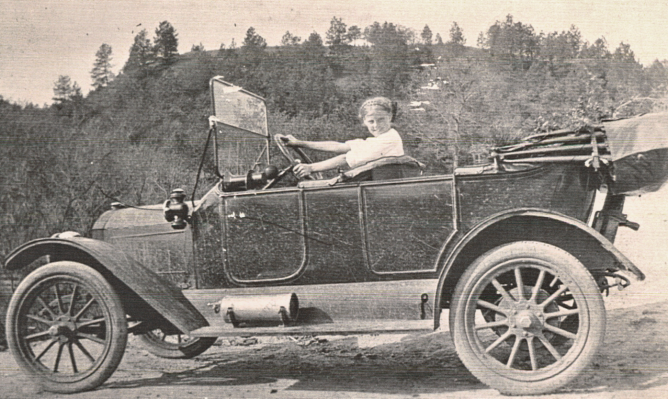 When the automobile first came out, very few people had one. Like most things when they first come out, they were first thought of as frivolous. If people could have seen the world as we see it today, they would not only have been shocked, but they would have understood the need to have one of those new fangled contraptions. Nevertheless, like any new invention, they soon caught on, and more people traded off their wagon for the automobile. It was a slow process, however, and many people thought the ones who had the first automobiles were a bit snooty, or that they were using the automobile as a status symbol…and maybe to a degree they were. It’s like that today too. First it was the computer, then the laptop, then the cell phone, then the smart phone, then the iPad…and the list goes on, depending on what you are into.
When the automobile first came out, very few people had one. Like most things when they first come out, they were first thought of as frivolous. If people could have seen the world as we see it today, they would not only have been shocked, but they would have understood the need to have one of those new fangled contraptions. Nevertheless, like any new invention, they soon caught on, and more people traded off their wagon for the automobile. It was a slow process, however, and many people thought the ones who had the first automobiles were a bit snooty, or that they were using the automobile as a status symbol…and maybe to a degree they were. It’s like that today too. First it was the computer, then the laptop, then the cell phone, then the smart phone, then the iPad…and the list goes on, depending on what you are into.
When the automobile came out, they scared the horses, who had to use the same roads, and they scared the people too, because the seemed to have no controls. They weren’t sure the machine could be stopped. They thought it might be a death trap. And it can be, if it is misused, but as we all know, it can also be a very useful tool in our everyday lives. The problem the people of those early years had was that it was an unknown. That made it much more scary. They also felt that what they had was good enough, which is the same as many people today think too.
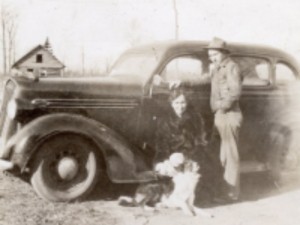
As the years went by though, the car became a common thing. Everyone has one these days…or almost. We are so used to cars that we think nothing of our 16 year old children driving them. We know how they work…in fact, most 15 year olds know how they work. As commonplace as they are, I think most people still feel like they are a status symbol, and we try to have one that reflects who we are. Nevertheless, when you look at the old pictures of people with those older cars, you could see that they really knew the value of that machine, and they didn’t take it for granted like we do today. Status symbol…yes, then and now, but maybe it meant a little more to them then.

 In 1910 – 1911, my Grandpa Spencer and my grandma’s brother, my Uncle Albert Schumacher, spent the winter months trapping and working in the logging camps in northern Minnesota. This was before my grandparents were married. The men took several pictures before embarking on the journey from the Schumacher farm in Elliot, North Dakota in September 1910 for their “winter in the woods”. My grandpa took his 1895 Winchester 30-03, the gun that was his pride and joy, and Uncle Albert had a 1899 Savage and they headed off on their adventure. It would be a winter to remember. It was freezing cold, often getting down to 30° below zero.
In 1910 – 1911, my Grandpa Spencer and my grandma’s brother, my Uncle Albert Schumacher, spent the winter months trapping and working in the logging camps in northern Minnesota. This was before my grandparents were married. The men took several pictures before embarking on the journey from the Schumacher farm in Elliot, North Dakota in September 1910 for their “winter in the woods”. My grandpa took his 1895 Winchester 30-03, the gun that was his pride and joy, and Uncle Albert had a 1899 Savage and they headed off on their adventure. It would be a winter to remember. It was freezing cold, often getting down to 30° below zero.
They built what they called a flat boat to carry their supplies, two rifles, two handguns, plenty of ammunition, and plenty of dried and canned food. The boat could also be loaded onto a wagon when they needed to travel across country, although, I’m not sure where they got the wagon after traveling by water. Still since I have seen the picture with the boat on the wagon, I know that they got that part covered as well. In the end, the cold winter sort of won out. They trapped during October and November and then worked in the logging camps until spring.
While the cold winter, and the freezing conditions did change their plans for the winter, you could still say that they had a successful winter of trapping anyway. Now, I don’t know how I would feel about trapping skunk, because at some point you have to go and deal with that carcass, and to me that would be horrible. We have all driven by a spot where a skunk was killed, and…whew, what a smell!! Nevertheless, my grandpa and my uncle took that in stride and came away with a good amount of skunk and muskrat pelts for their efforts. My Uncle Bill, who I must credit for the information in this story, figured that in all, 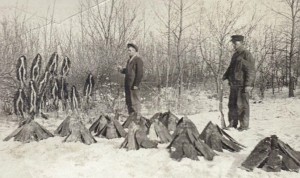
 they probably made about $100.00 for that cold winter’s trapping venture, plus the money earned while working in the logging camps. It may not sound like much money for all that work and the freezing conditions, but in 1910 and 1911, it was a pretty decent wage.
they probably made about $100.00 for that cold winter’s trapping venture, plus the money earned while working in the logging camps. It may not sound like much money for all that work and the freezing conditions, but in 1910 and 1911, it was a pretty decent wage.
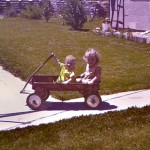 When you are a little kid, your friends are usually siblings or cousins. Since there is not much choice of who your friends are, at this age, all you can do is hope you get along pretty well. Thankfully for me and for my girls, that was exactly the case. While the girls had their typical little kid tiffs, for the most part, they were best friends. They did everything together. I didn’t have to find ways to entertain them for very long, because they took over that job very early on. As soon as Amy was able to play, they were always making up their own games. It was entertaining to watch them play.
When you are a little kid, your friends are usually siblings or cousins. Since there is not much choice of who your friends are, at this age, all you can do is hope you get along pretty well. Thankfully for me and for my girls, that was exactly the case. While the girls had their typical little kid tiffs, for the most part, they were best friends. They did everything together. I didn’t have to find ways to entertain them for very long, because they took over that job very early on. As soon as Amy was able to play, they were always making up their own games. It was entertaining to watch them play.
Corrie and Amy never fought much, and in fact, I actually had people comment on that fact. It made it easy to have them do things together. Everything from riding around in a wagon together or even riding…or being pushed on the same tricycle. They loved that neither of them had to wait their turn. It also made Corrie feel like a big girl when she could hold her sister in place so she didn’t fall off. I loved how protective Corrie was of her little sister. It was very sweet.
It’s not very often that you can turn a normal tricycle into a tricycle built for two, but when kids are little, you can fit two little ones on a tricycle. And Amy was just so excited to be on there. She felt like a big girl too, and when someone pushed them around the patio, they were in seventh Heaven. Of course, pushing a tricycle around a patio all day can get pretty old pretty fast. Nevertheless, to make for happy toddlers, pushing them around on a tricycle is the 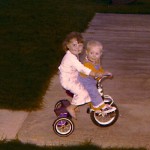 perfect solution…temporarily. Too much pushing the kids around the patio can make for happy kids…and worn out adults.
perfect solution…temporarily. Too much pushing the kids around the patio can make for happy kids…and worn out adults.
Those early childhood days, when your siblings are your best friends, go by so fast. When I look at the fun my girls had, just hanging out together, it always puts a smile on my face. They are still close, but can siblings ever be as close as adults as they were as toddlers? I don’t see how they could. People get so busy, and besides, can anything ever compare to the fun times you had with your sister, when you were little kids?
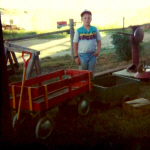 From the time he was just a little boy, my nephew, Barry loved all things wheel related…from wagons to trucks, and especially tractors. Of course, when he was little he wasn’t allowed to do much serious driving, so he had to settle for a wagon or an old tractor that didn’t run. He was a serious macho man. He even wanted to forgo the entire school experience to stay home and work on trucks with his grandpa.
From the time he was just a little boy, my nephew, Barry loved all things wheel related…from wagons to trucks, and especially tractors. Of course, when he was little he wasn’t allowed to do much serious driving, so he had to settle for a wagon or an old tractor that didn’t run. He was a serious macho man. He even wanted to forgo the entire school experience to stay home and work on trucks with his grandpa.
As he grew, and found out that refusal to attend school was not an option, he discovered that school had a few redeeming aspects after all…the girls. Like all little boys, this discovery made going to school bearable. He also found a new use for his wheels…and his first chick magnet was born. That was about 1987, and not much has changed as far as Barry’s love for most types of wheeled vehicles. These days, however, his chick magnet is reserved for the one chick that has the key to his heart…his wife Kelli.
Of course, Kelli probably wouldn’t go very far with him in the 1987 version of the chick magnet, so Barry has had to upgrade to a newer version…the pickup truck. Every girl would agree that while his wagon was very cute, it just doesn’t work well for going out on the town. And, lets face it, having your boyfriend pull you around in a wagon, would be a little bit embarrassing for a person in their twenties. That sort of thing tends to make you 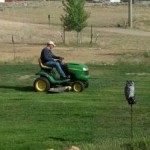 look a little juvenile. Girls don’t really like that.
look a little juvenile. Girls don’t really like that.
Barry has not outgrown his love for wheels of any type though. His riding lawn mower has replaced the broken down tractor, and the four wheeler ha replaced the little wagon. It is long gone too, except for the memories in pictures. Still, Barry hasn’t changed all that much really. I wouldn’t be surprised if that little boy doesn’t still live somewhere inside the man he has become. I’ll bet that when he looks a a little wagon in pictures or at the store, he remembers the good old days when the wagon was all the wheels he needed.
 My dad was the younger brother. His sister Laura was 12 years older than he was, and his brother was 2 years older. Later there would be another sister, Ruth born in the family. The two brothers were, like most boys, always into something. I think Uncle Bill was so excited about having a little brother, that he set out to become a one man entertainment committee for my dad. He loved to make him laugh, and Uncle Bill could be quite funny…and mischievous. Through the years the two boys would get into lots of mischief, but when my dad was a little boy, his brother Bill was all about being a good big brother. He took his brother outside and played with him…which was a help to their mom too. He kept him laughing, and taught him how to do things…maybe not always a good thing.
My dad was the younger brother. His sister Laura was 12 years older than he was, and his brother was 2 years older. Later there would be another sister, Ruth born in the family. The two brothers were, like most boys, always into something. I think Uncle Bill was so excited about having a little brother, that he set out to become a one man entertainment committee for my dad. He loved to make him laugh, and Uncle Bill could be quite funny…and mischievous. Through the years the two boys would get into lots of mischief, but when my dad was a little boy, his brother Bill was all about being a good big brother. He took his brother outside and played with him…which was a help to their mom too. He kept him laughing, and taught him how to do things…maybe not always a good thing.
Dad loved his big brother, and like most little boys, loved having his big brother pull him around in the wagon. But then what kid doesn’t. The wagon is almost like having a car, except that you have to find a motor for it, and the best motor is a big brother who doesn’t mind doing all the work, so his little brother, or sister, can have a good time. And Uncle Bill was a good big brother. He and my dad had lots of adventures, many wagon rides, fishing trips, and other such good times, but after all…what are big brothers for.
My nephew, Barry was another of those good big brothers to his brothers when they were little. Barry is also 10 years older than his brother JD, and almost 12 years older than his brother Eric. Barry was a big helper when his brothers were little. It was even easier for him to pull them around in the wagon. And they, like all other little kids, totally loved it. Big brothers can be the coolest of friends when their little brothers a pretty little. It doesn’t always continue on into the teenage years, but usually resurfaces when they grow up.
Like my dad and his brother, Barry and his brothers, JD and Eric are best of friends to this day. I think there is a bond between brothers that is very special. They are friends no matter the age difference. Yes, sisters have that too, but it is very different than brothers. When I look at how these boys were with each other, its easy to see that the little guys look up to the big guys…want to be just like them, and the big guys, whether they admit it or not, think their little brother is the greatest. They want to show their little brothers the ropes, do the guy things, and help them grow into good men, because after all, what are big brothers for.

